Sustainability as a Challenge and Driver for Novel Ecosystemic 6G Business Scenarios
Abstract
1. Introduction
2. Materials and Methods
2.1. Scenario Planning Process
- Defining the focus and relevant time frame: 6G business in 2030–2035, and the global change drivers and focus domains of information technology and electrical engineering research towards the year 2030
- Identification of key factors and driving forces behind the scenarios
- Assessment of the forces in the previous step and choosing the key trends and uncertainties. The assessment was based on the anticipated impact (from small to great) and predictability of consequences (from known to unknown)
- Establishment of the scenario logic based on two orthogonal (unrelated) dimensions that represent significant uncertainties within the selected scenario focus and timeframe
- Creation of the scenario contents for each scenario by building on the identified trends and uncertainties
- Assessment and evaluation of the generated scenarios for their internal consistency, depth and richness of detail, plausibility, and stakeholder behavior [42]
2.2. Business Model Perspective
2.3. The Quintuple Helix Model
3. Results
3.1. Indentified Forces
3.2. Developed Scenarios for 6G
3.2.1. User Experience Theme #1
Customer6.0 Scenario 1A
I Robot Scenario 1B
Smart Society Scenario 1C
Communities Scenario 1D
3.2.2. Business Theme #2
Edge Scenario 2A
Telco Broker Scenario 2B
MNO6.0 Scenario 2C
Over-the-Top Scenario 2D
3.2.3. Sustainability Theme #3
Gaia Scenario 3A
Multi-Local Scenario 3B
Dystopia Scenario 3C
The Race Scenario 3D
3.2.4. Geopolitics Theme #4
European Haven Scenario 4A in the World of Blocks Scenario 4B
China Superpower Scenario 4C
US Order Scenario 4D
3.2.5. Scenario Summary
4. Discussion
- The customization of user experience will increase with the help of user-centric resource orchestration models
- Localized—especially for spatial circular economies—demand–supply–consumption models will become prominent at a global level
- Community-driven networks and public–private partnerships (PPP) will bring about new societal models for future service provisioning
- Platform ecosystems will extend from offering search, social media, and e-commerce to providing infrastructures for innovation and transactions
- 6G will have a strong role in various vertical and industrial contexts
- Lowering the market entry barriers will be enabled by the decoupling of technology platforms, making it possible for multiple entities to contribute to 6G innovations
- Smaller payers will be able to provide highly specialized solutions and services due to fine-grained modularity and open-source
- Decentralized platform cooperatives will start to challenge the existing “winner-takes-all” platform monopolies.
- Hybrid threats and influence will be exercised by various economic, technological, cultural, and military powers
- Different tensions between the competitive, protective, networked, and empowered worldviews will emerge
- The global power configuration may be transformed from a multipolarized to a poly-nodal world where power will be determined in networks of economic, technological, and cultural interaction
- Empowering citizens as knowledge producers and users will contribute to a process of human-centered, democratized innovation, contributing to pluralism and increased diversity
- Privacy regulation will be strongly influenced by the increased platform data economy or sharing economy, emergence of intelligent assistants (AI), connected living in smart cities, transhumanism, and digital twins.
- 6G will enable services that help to steer communities and countries towards reaching the UN SDGs
- 6G will enable monitoring and steering the circular economy, thereby also helping to create better understanding of the big picture of sustainable data economy
- Sharing- and circular economy-based co-creation will enable promoting sustainable interaction also with existing resources and processes
- Companies will be able to develop products and technologies that innovate to zero, for example, zero-waste and zero-emission technologies
- The 6G-enabled immersive digital realities will facilitate novel ways of learning, understanding, and memorizing in several fields of science.
5. Conclusions
Author Contributions
Funding
Acknowledgments
Conflicts of Interest
References
- Ahokangas, P.; Matinmikko-Blue, M.; Yrjölä, S.; Seppänen, V.; Hämmäinen, H.; Jurva, R.; Latva-aho, M. Business Models for Local 5G Micro Operators. In Proceedings of the IEEE International Symposium on Dynamic Spectrum Access Networks (DySPAN), Seoul, Korea, 22–25 October 2018. [Google Scholar]
- Ahokangas, P.; Matinmikko-Blue, M.; Yrjölä, S.; Seppänen, V.; Hämmäinen, H.; Jurva, R.; Latva-aho, M. Business Models for Local 5G Micro Operators. IEEE Trans. Cogn. Commun. Netw. 2018, 5, 730–740. [Google Scholar] [CrossRef]
- Alvarez, F.; Breitgand, D.; Griffin, D.; Andriani, P.; Rizou, S.; Zioulis, N.; Moscatelli, F.; Serrano, J.; Keltsch, M.; Trakadas, P.; et al. An Edge-to-Cloud Virtualized Multimedia Service Platform for 5G Networks. IEEE Trans. Broadcast. 2019, 65, 369–380. [Google Scholar] [CrossRef]
- Yrjölä, S.; Ahokangas, P.; Matinmikko-Blue, M. Novel Context and Platform Driven Business Models via 5G Networks. In Proceedings of the IEEE 29th Annual International Symposium on Personal, Indoor and Mobile Radio Communications (PIMRC), Bologna, Italy, 9–12 September 2018. [Google Scholar]
- Latva-aho, M.; Leppänen, K. (Eds.) Key Drivers and Research Challenges for 6G Ubiquitous Wireless Intelligence; 6G Flagship Program; University of Oulu: Oulu, Finland, 2019. [Google Scholar]
- Matinmikko-Blue, M.; Aalto, S.; Asghar, M.I.; Berndt, H.; Chen, Y.; Dixit, S.; Jurva, R.; Karppinen, P.; Kekkonen, M.; Kinnula, M.; et al. (Eds.) White Paper on 6G Drivers and the UN SDGs; 6G Research Visions, No. 2; University of Oulu: Oulu, Finland, 2020; Available online: http://urn.fi/urn:isbn:9789526226699 (accessed on 24 July 2020).
- Carayannis, E.G.; Campbell, D.F.J. Smart Quintuple Helix Innovation Systems; Springer International Publishing: Basel, Switzerland, 2019. [Google Scholar]
- Hassenzahl, M. User experience (UX): Towards an experiential perspective on product quality. In Proceedings of the 20th Conference on l’Interaction Homme-Machine (IHM ’08) Association for Computing Machinery, New York, NY, USA, 2–5 September 2018; pp. 11–15. [Google Scholar] [CrossRef]
- Kuhlman, T.; Farrington, J. What is sustainability? Sustainability 2010, 2, 3436–3448. [Google Scholar] [CrossRef]
- Evans, S.; Vladimirova, D.; Holgado, M.; van Fossen, K.; Yang, M.; Silva, E.A.; Barlow, C.Y. Business Model Innovation for Sustainability: Towards a Unified Perspective for Creation of Sustainable Business Models. Bus. Strateg. Environ. 2017, 26, 597–608. [Google Scholar] [CrossRef]
- de Mattos, C.S.; Fettermann, D.C.; Cauchick-Miguel, P.A. Service modularity: Literature overview of concepts, effects, enablers, and methods. Serv. Ind. J. 2019. [Google Scholar] [CrossRef]
- Gawer, A. Bridging differing perspectives on technological platforms: Toward an integrative framework. Res. Policy 2014, 43, 1239–1249. [Google Scholar] [CrossRef]
- Teece, D. Profiting from innovation in the digital economy: Enabling technologies, standards, and licensing models in the wireless world. Res. Policy 2018, 47, 1367–1387. [Google Scholar] [CrossRef]
- Yrjölä, S.; Ahokangas, P.; Matinmikko-Blue, M. Novel Platform-based Ecosystemic Business Models in the Future Mobile Operator Business. In Proceedings of the 3rd Business Model Conference, New York, NY, USA, 3–4 June 2019. [Google Scholar]
- Koumaras, H.; Tsolkas, D.; Gardikis, G.; Gomez, P.M.; Frascolla, V.; Triantafyllopoulou, D.; Emmelmann, M.; Koumaras, V.; Osma, M.L.; Munaretto, D.; et al. 5GENESIS: The Genesis of a flexible 5G Facility. In Proceedings of the IEEE 23rd International Workshop on Computer Aided Modeling and Design of Communication Links and Networks (CAMAD), Barcelona, Spain, 17–19 September 2018; pp. 1–6. [Google Scholar]
- Noll, J.; Chowdhury, M.M. 5G: Service continuity in heterogeneous environments. Wirel. Pers. Commun. 2011, 57, 413–429. [Google Scholar] [CrossRef]
- Ballon, P. The Platformization of the European Mobile Industry. Comms Strateg. 2009, 75, 15. [Google Scholar]
- Rasheed, T.; Radwan, A.; Rodriguez, J.; Kibilda, J. Business Models for Cooperation. In Energy Efficient Smart Phones for 5G Networks; Radwan, A., Rodriguez, J., Eds.; Springer International Publishing: Basel, Switzerland, 2016; pp. 241–267. [Google Scholar]
- Valtanen, K.; Backman, J.; Yrjola, S. Blockchain Powered Value Creation in the 5G and Smart Grid Use Cases. IEEE Access 2019, 7, 25690–25707. [Google Scholar] [CrossRef]
- Gonçalves, V.; Ballon, P. Adding value to the network: Mobile operators’ experiments with Software-as-a-Service and Platform-as-a-Service models. Telemat. Inform. 2011, 28, 12–21. [Google Scholar] [CrossRef]
- Zhang, N.; Cheng, N.; Gamage, A.T.; Zhang, K.; Mark, J.W.; Shen, X. Cloud assisted HetNets toward 5G wireless networks. IEEE Commun. Mag. 2015, 53, 59–65. [Google Scholar] [CrossRef]
- Ahokangas, P.; Moqaddamerad, S.; Matinmikko, M.; Abouzeid, A.; Atkova, I.; Gomes, J.F.; Iivari, M. Future micro operators business models in 5G. Bus. Manag. Rev. 2016, 7, 143–149. [Google Scholar]
- Matinmikko, M.; Latva-aho, M.; Ahokangas, P.; Yrjölä, S.; Koivumäki, T. Micro operators to boost local service delivery in 5G. Wirel. Pers. Commun. 2017, 95, 69–82. [Google Scholar] [CrossRef]
- Ahokangas, P.; Matinmikko, M.; Yrjola, S.; Okkonen, H.; Casey, T. “Simple rules” for mobile network operators’ strategic choices in future cognitive spectrum sharing networks. IEEE Wirel. Commun. 2013, 20, 20–26. [Google Scholar] [CrossRef]
- Viswanathan, H.; Mogensen, P.E. Communications in the 6G Era. IEEE Access 2020, 8, 57063–57074. [Google Scholar] [CrossRef]
- Saad, W.; Bennis, M.; Chen, M. A Vision of 6G Wireless Systems: Applications, Trends, Technologies, and Open Research Problems. IEEE Netw. 2019, 34, 134–142. [Google Scholar] [CrossRef]
- Letaief, K.B.; Chen, W.; Shi, Y.; Zhang, J.; Zhang, Y.A. The Roadmap to 6G: AI Empowered Wireless Networks. IEEE Commun. Mag. 2019, 57, 84–90. [Google Scholar] [CrossRef]
- Ziegler, V.; Yrjölä, S. 6G Indicators of Value and Performance. In Proceedings of the 2nd 6G Wireless Summit, Levi, Finland, 17–20 March 2020. [Google Scholar]
- Matinmikko-Blue, M.; Yrjölä, S.; Ahokangas, P. Spectrum Management in the 6G Era: Role of Regulations and Spectrum Sharing. In Proceedings of the 2nd 6G Wireless Summit, Levi, Finland, 17–20 March 2020. [Google Scholar]
- Yrjölä, S. How could Blockchain transform 6G towards open ecosystemic business models? In Proceedings of the IEEE ICC 2020 Workshop on Blockchain for IoT and CPS, Dublin, Ireland, 7–11 June 2020. [Google Scholar]
- Ahokangas, P.; Yrjölä, S.; Matinmikko-Blue, M.; Seppänen, V. Transformation towards 6G ecosystem. In Proceedings of the 2nd 6G Wireless Summit, Levi, Finland, 17–20 March 2020. [Google Scholar]
- Yrjölä, S.; Ahokangas, P.; Matinmikko-Blue, M. (Eds.) White Paper on Business of 6G; 6G Research Visions, No. 3; University of Oulu: Oulu, Finland, 2020; Available online: http://urn.fi/urn:isbn:9789526226767 (accessed on 24 July 2020).
- Stevenson, T. Anticipatory action learning: Conversations about the future. Futures 2012, 34, 417–425. [Google Scholar] [CrossRef]
- Inayatullah, S. Causal layered analysis. Poststructuralism as method. Futures 1998, 30, 815–829. [Google Scholar] [CrossRef]
- Inayatullah, S. Anticipatory action learning: Theory and practice. Futures 2005, 38, 656–666. [Google Scholar] [CrossRef]
- Schoemaker, P. Scenario Planning: A tool for Strategic Thinking. Sloan Manag. Rev. 1995, 36, 25–50. [Google Scholar]
- Schwartz, P. The Art of the Long View; Doubleday Business: New York, NY, USA, 1991. [Google Scholar]
- Zott, C.; Amit, R. Designing your future business model: An activity system perspective. Long Range Plan. 2010, 43, 216–226. [Google Scholar] [CrossRef]
- Massa, L.; Tucci, C.; Afuah, A.A. Critical assessment of business model research. Acad. Manag. Annu. 2017, 11, 73–104. [Google Scholar] [CrossRef]
- Stewart, C. Integral scenarios: Reframing theory, building from practice. Futures 2007, 40, 160–172. [Google Scholar] [CrossRef]
- Collins, T.; Hines, A. The evolution of integral futures. A status update. World Future Rev. 2010, 2, 5–16. [Google Scholar] [CrossRef]
- Voros, J. A generic foresight process framework. Foresight 2003, 5, 10–21. [Google Scholar] [CrossRef]
- Inayatullah, S. Six Pillars: Futures Thinking for Transforming. Foresight 2008, 10, 4–21. [Google Scholar] [CrossRef]
- Dreborg, K.H. Essence of backcasting. Futures 1996, 28, 813–828. [Google Scholar] [CrossRef]
- 6G Flagship White Papers. 2020. Available online: https://www.6gchannel.com/6g-white-papers/ (accessed on 24 July 2020).
- Zott, C.; Amit, R.; Massa, L. The business model: Recent developments and future research. J. Manag. 2001, 37, 1019–1042. [Google Scholar]
- Onetti, A.; Zucchella, A.; Jones, M.; McDougal-Covin, P. Internationalization, innovation and entrepreneurship: Business models for new technology-based firms. J. Manag. Gov. 2012, 16, 337–368. [Google Scholar] [CrossRef]
- Amit, R.; Zott, C. Value creation in E-business. Strateg. Manag. J. 2001, 22, 493–520. [Google Scholar] [CrossRef]
- Morris, M.; Schindehutte, M.; Allen, J. The entrepreneur’s business model: Toward a unified perspective. J. Bus. Res. 2005, 58, 726–735. [Google Scholar] [CrossRef]
- Teece, D. Business models, business strategy and innovation. Long Range Plan. 2010, 43, 172–194. [Google Scholar] [CrossRef]
- McGrath, R. Business models: A discovery driven approach. Long Range Plan. 2010, 43, 247–261. [Google Scholar] [CrossRef]
- Gomes, J.F.; Iivari, M.; Pikkarainen, M.; Ahokangas, P. Business Models as Enablers of Ecosystemic Interaction: A Dynamic Capability Perspective. Int. J. Soc. Ecol. Sustain. Dev. 2018, 9, 1–13. [Google Scholar] [CrossRef]
- Osterwalder, A.; Pigneur, Y. Business Model Generation: A Handbook for Visionaries, Game Changers, and Challengers; John Wiley & Sons: Hoboken, NJ, USA, 2010. [Google Scholar]
- Stampfl, G.; Prügl, R.; Osterloh, V. An explorative model of business model scalability. Int. J. Prod. Dev. 2013, 18, 226–248. [Google Scholar] [CrossRef]
- Aspara, J.; Hietanen, J.; Tikkanen, H. Business model innovation vs. replication: Financial performance implications of strategic emphases. J. Strateg. Mark. 2010, 18, 39–56. [Google Scholar] [CrossRef]
- Schaltegger, S.; Hansen, E.; Lüdeke-Freund, F. Business models for sustainability: Origins, present research, and future avenues. Organ. Environ. 2016, 29, 3–10. [Google Scholar] [CrossRef]
- Xu, Y. Open Business Models for Future Smart Energy: A Value Perspective. Ph.D. Thesis, University of Oulu, Oulu, Finland, 2019. [Google Scholar]
- Porter, M.E. What is strategy? Harv. Bus. Rev. 1996, 74, 61–78. [Google Scholar]
- Casadesus-Masanell, R.; Ricart, J.E. How to design a winning business model. Harv. Bus. Rev. 2011, 89, 100–107. [Google Scholar]
- Bereznoi, A. Business model innovation in corporate competitive strategy. Probl. Econ. Transit. 2015, 57, 14–33. [Google Scholar] [CrossRef]
- Vargo, S.L.; Lusch, R.F. Institutions and axioms: An extension and update of service-dominant logic. J. Acad. Mark. Sci. 2016, 44, 5–23. [Google Scholar] [CrossRef]
- Mazhelis, A.; Mazhelis, O. Software business. In Proceedings of the 3rd International Conference on Software Business ICSOB 2012, Cambridge, MA, USA, 18–20 June 2012; pp. 261–266. [Google Scholar]
- Futures Platform. Discover the World After COVID-19; Futures Platform: Helsinki, Finland, 2020. [Google Scholar]
- Carayannis, E.G.; Barth, T.D.; Campbell, D.F. The Quintuple Helix innovation model: Global warming as a challenge and driver for innovation. J. Innov. Entrep. 2012, 1, 1–12. [Google Scholar] [CrossRef]
- Von Hippel, E. Democratizing Innovation; Oxford University Press: Oxford, UK, 2005. [Google Scholar]
- ABI Research. 54 Technology Trends to Watch in 2020; ABI Research: Oyster Bay, NY, USA, 2020. [Google Scholar]
- Analysys Mason Research. Telecoms, Media and Technology Predictions for 2020; Deloitte Insights: New York, NY, USA, 2020. [Google Scholar]
- Business Finland. Alternative Scenarios for the Future; Business Finland: Helsinki, Finland, 2020. [Google Scholar]
- DTTL. To Be or Not to Be—The Future of the Telco Business Model; Deloitte Touche Tohmatsu Limited: London, UK, 2017. [Google Scholar]
- Dufva, M. Megatrends 2020. Sitra Studies 162; Sitra: Helsinki, Finland, 2020. [Google Scholar]
- Ericsson. 10 Hot Consumer Trends 2030; Ericsson: Stockholm, Sweden, 2020. [Google Scholar]
- Gaub, F. Global Trends to 2030: Challenges and Choices for Europe; The European Union Institute for Security Studies: Paris, France, 2019. [Google Scholar]
- FG-NET-2030. Network 2030—A Blueprint of Technology, Applications and Market Drivers Towards the Year 2030 and Beyond; ITU-T: Paris, France, 2019. [Google Scholar]
- Frost and Sullivan. Global Mega Trends to 2030—Futurecasting Key Themes That Will Shape Our Future Lives; Frost and Sullivan: San Antonio, TX, USA, 2020. [Google Scholar]
- GSMA. 2019 Mobile Industry Impact Report: Sustainable Development Goals; GSMA: London, UK, 2019. [Google Scholar]
- GSMA. Global Mobile Trends 2020—New Decade, New Industry; GSMA: London, UK, 2020. [Google Scholar]
- Huawei. Huawei Global Industry Vision Report; Huawei: Shenzhen, China, 2019. [Google Scholar]
- McKinsey Global Institute. Navigating a World of Disruption, Briefing Note Prepared for the World Economic Forum; McKinsey Global Institute: Davos, Switzerland, 2019. [Google Scholar]
- Oliver Wyman. Nokia Megatrends in Telecommunications—How Service Providers around the World Are Taking Control of an Industry in Transition; Oliver Wyman: New York, NY, USA, 2020. [Google Scholar]
- Ripple, W.J.; Wolf, C.; Newsome, T.M.; Galetti, M.; Alamgir, M.; Crist, E.; Mahmoud, M.I.; Laurance, W.F. World Scientists’ Warning to Humanity: A Second Notice. BioScience 2017, 67, 1026–1028. [Google Scholar] [CrossRef]
- UN. Resolution Adopted by the General Assembly on Transforming Our World: The 2030 Agenda for Sustainable Development (A/RES/70/1); United Nations: New York, NY, USA, 2015. [Google Scholar]
- UN. Global Sustainable Development Report 2019: The Future Is Now—Science for Achieving Sustainable Development; United Nations: New York, NY, USA, 2019. [Google Scholar]
- WEF. The Impact of 5G: Creating New Value across Industries and Society; World Economic Forum: Geneva, Switzerland, 2020. [Google Scholar]
- Cruz, C.O.; Sarmento, J.M. “Mobility as a Service” Platforms: A Critical Path towards Increasing the Sustainability of Transportation Systems. Sustainability 2020, 12, 6368. [Google Scholar] [CrossRef]
- Kantola, R. Net Neutrality Under EU Law—A Hindrance to 5G Success. In Proceedings of the 30th European Conference of the International Telecommunications Society (ITS): “Towards a Connected and Automated Society”, Helsinki, Finland, 16–19 June 2019. [Google Scholar]
- Kinnula, M.; Iivari, N. Empowered to Make a Change—Guidelines for Empowering the Young Generation in and through Digital Technology Design. In Proceedings of the FabLearn Europe Conference, Oulu, Finland, 28–29 May 2019; ACM: New York, NY, USA, 2019. [Google Scholar]
- Masini, B.M.; Silva, C.M.; Balador, A. The Use of Meta-Surfaces in Vehicular Networks. J. Sens. Actuator Netw. 2020, 9, 15. [Google Scholar] [CrossRef]
- Alsharif, M.H.; Kelechi, A.H.; Albreem, M.A.; Chaudhry, S.A.; Zia, M.S.; Kim, S. Sixth Generation (6G) Wireless Networks: Vision, Research Activities, Challenges and Potential Solutions. Symmetry 2020, 12, 676. [Google Scholar] [CrossRef]
- Moore, J.F. Predators and Prey: A New Ecology of Competition. Harv. Bus. Rev. 1993, 71, 75–86. [Google Scholar]
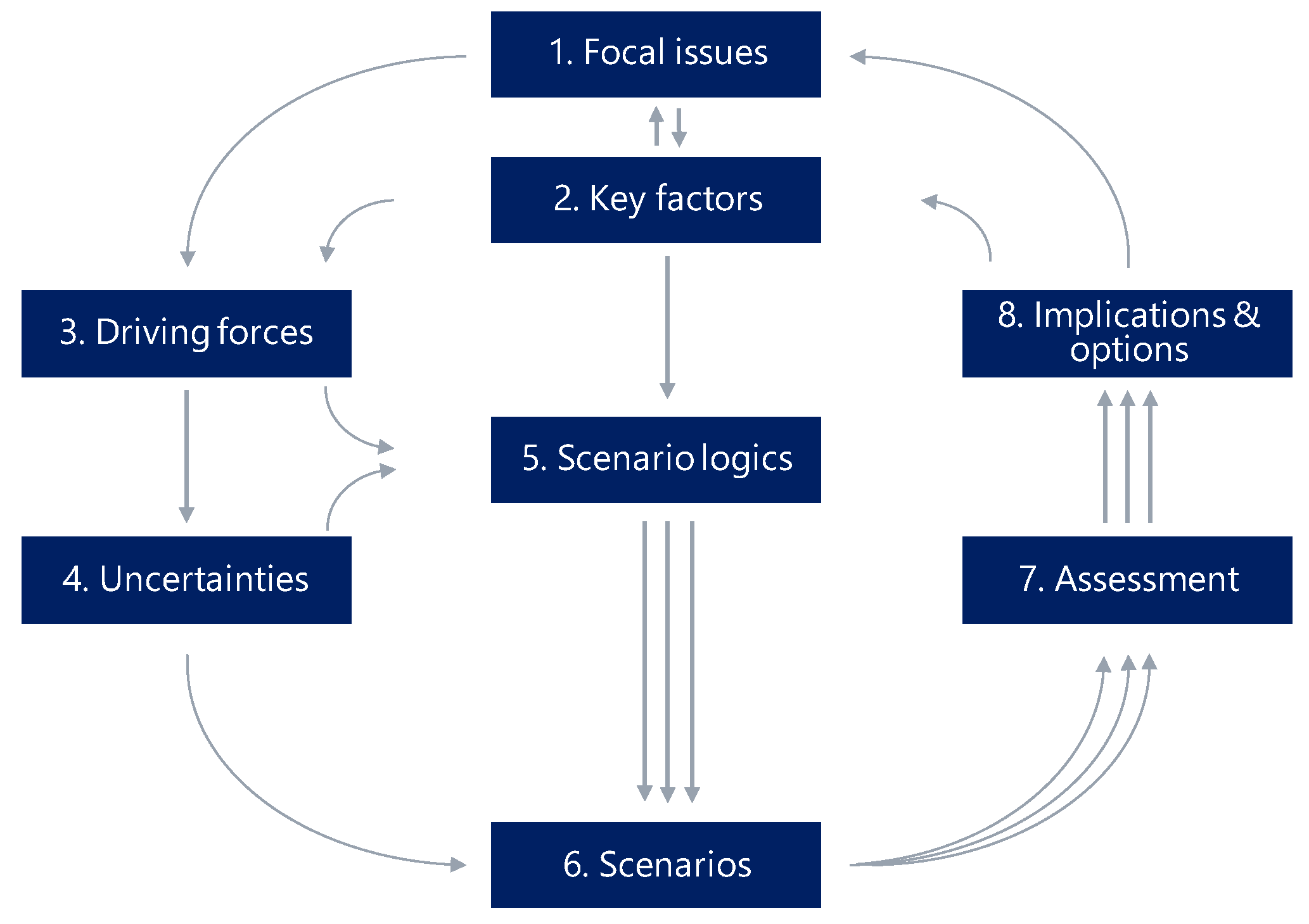
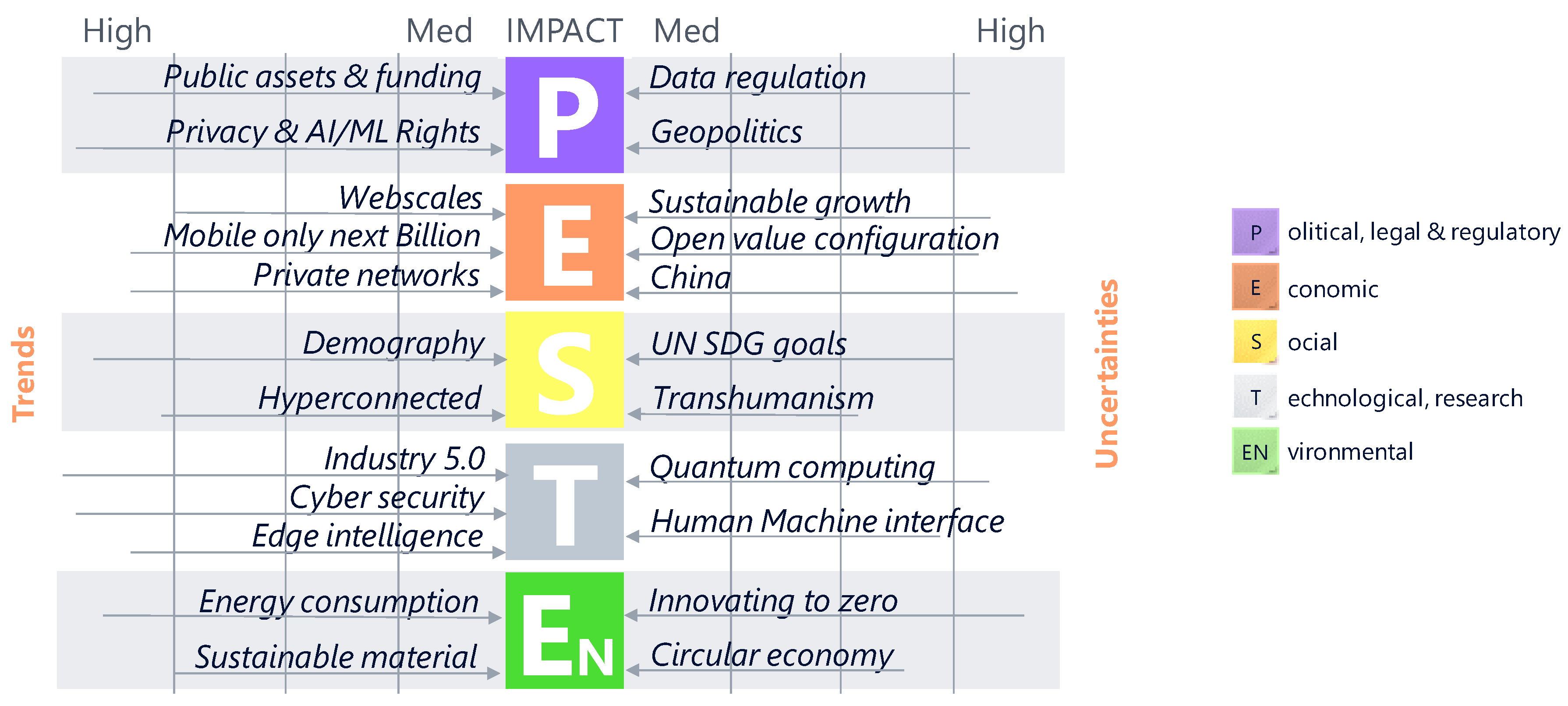
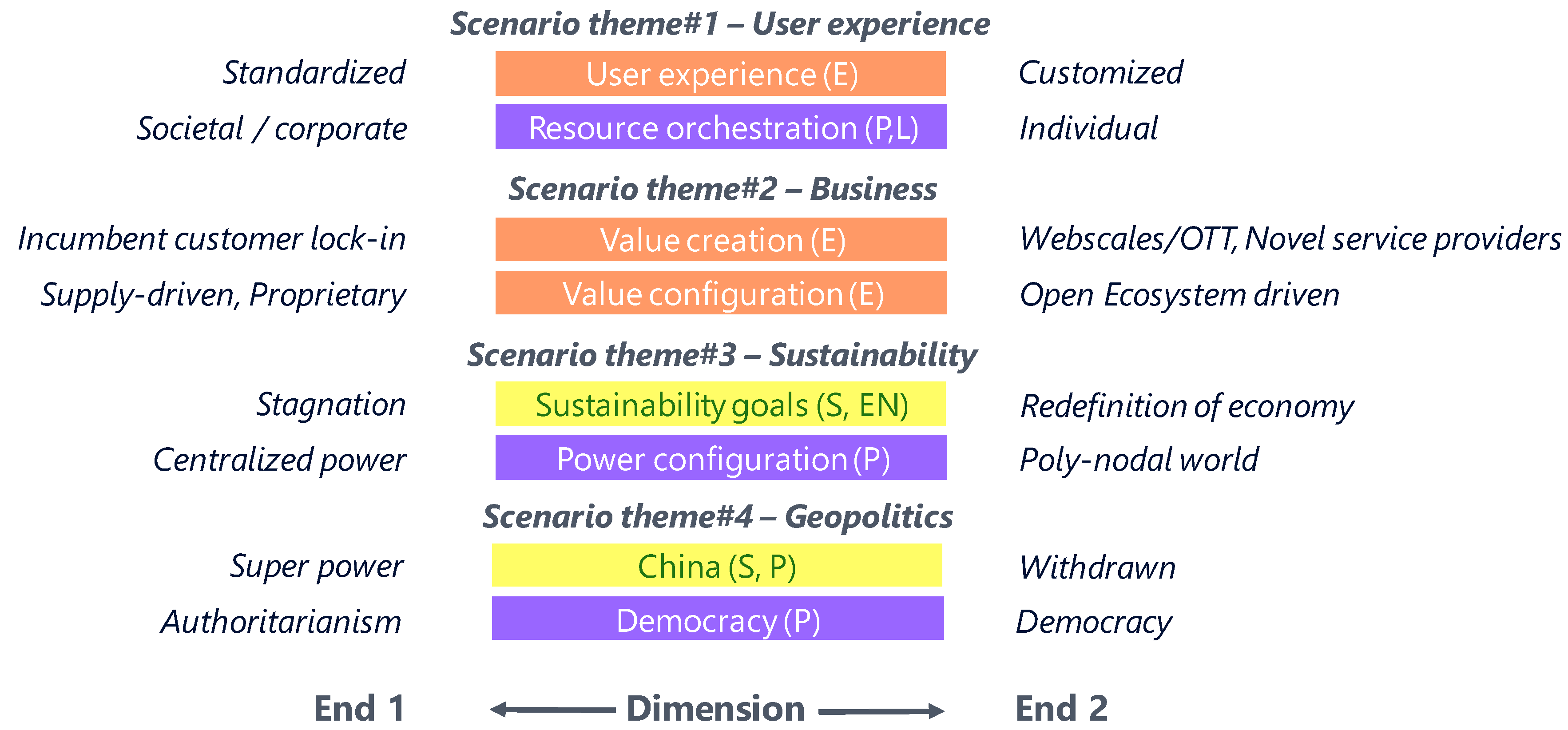
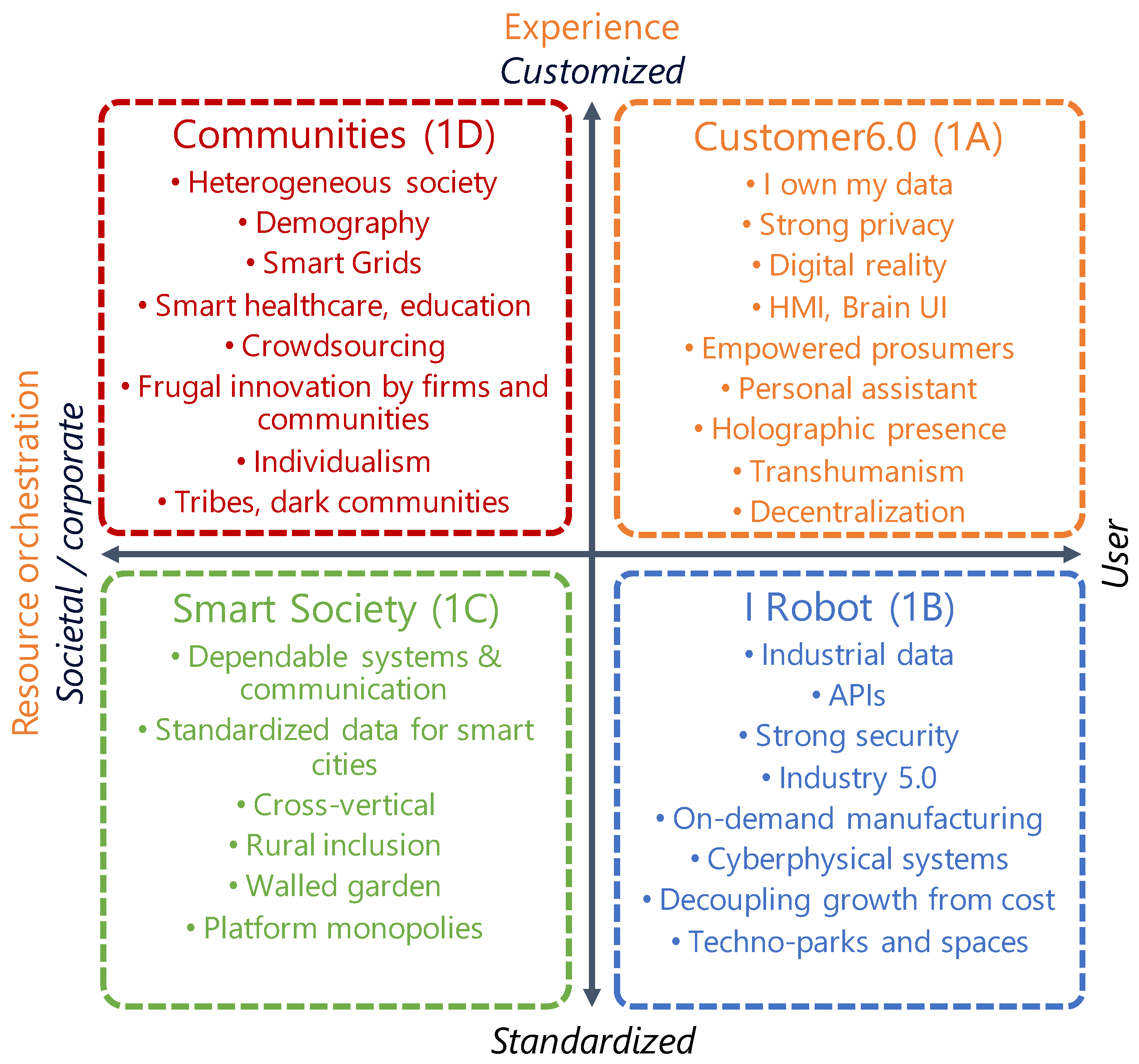
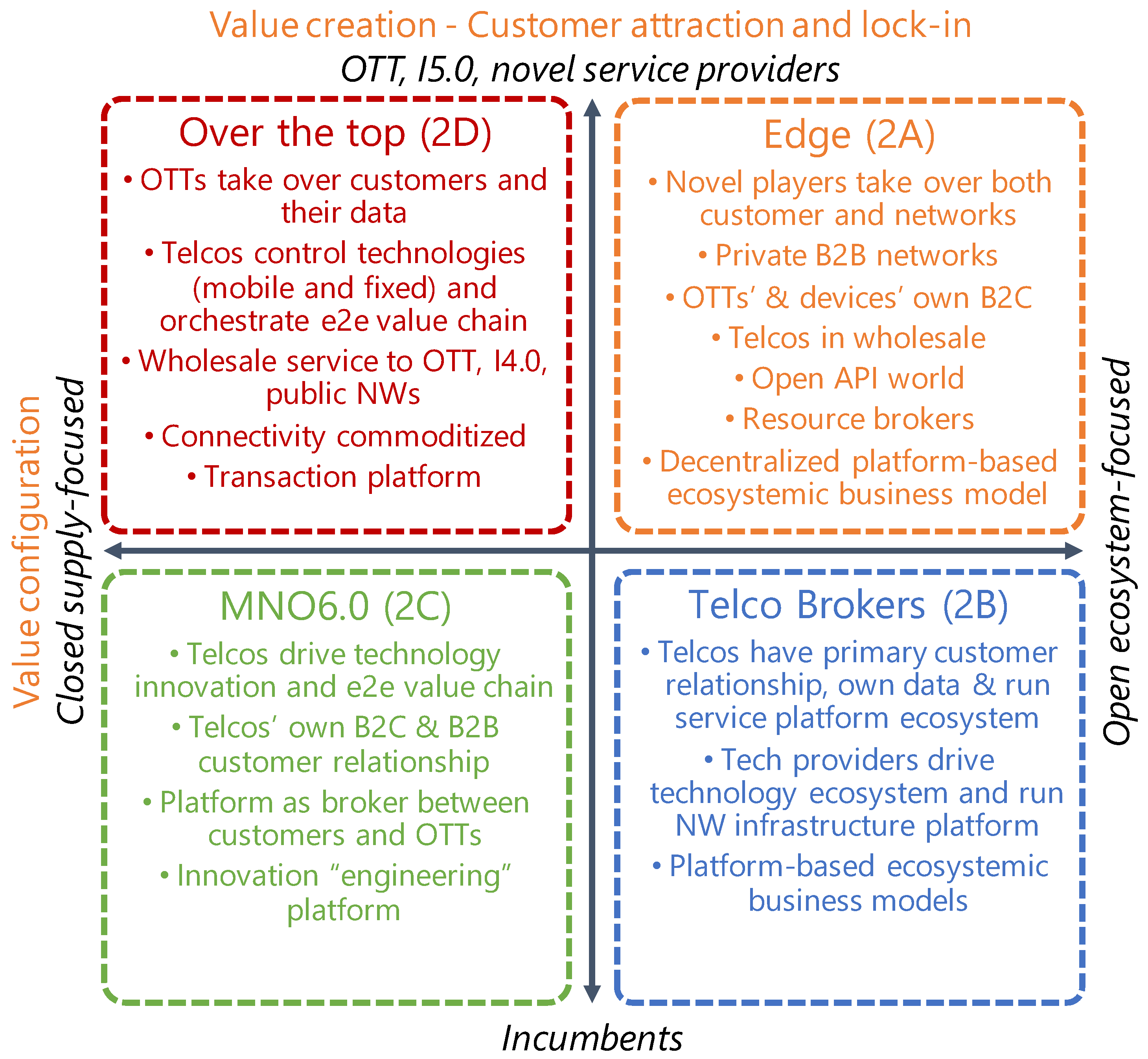
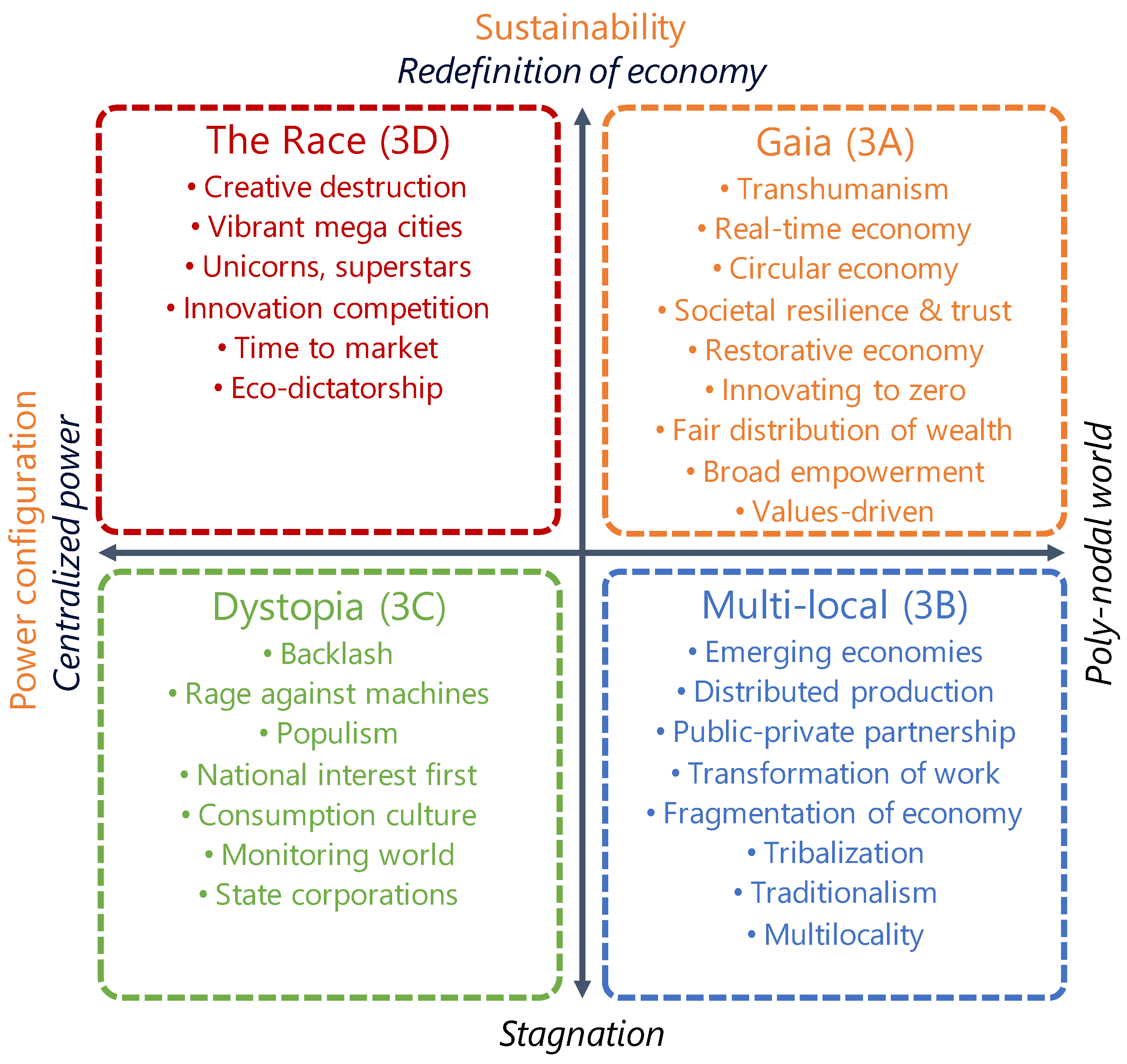


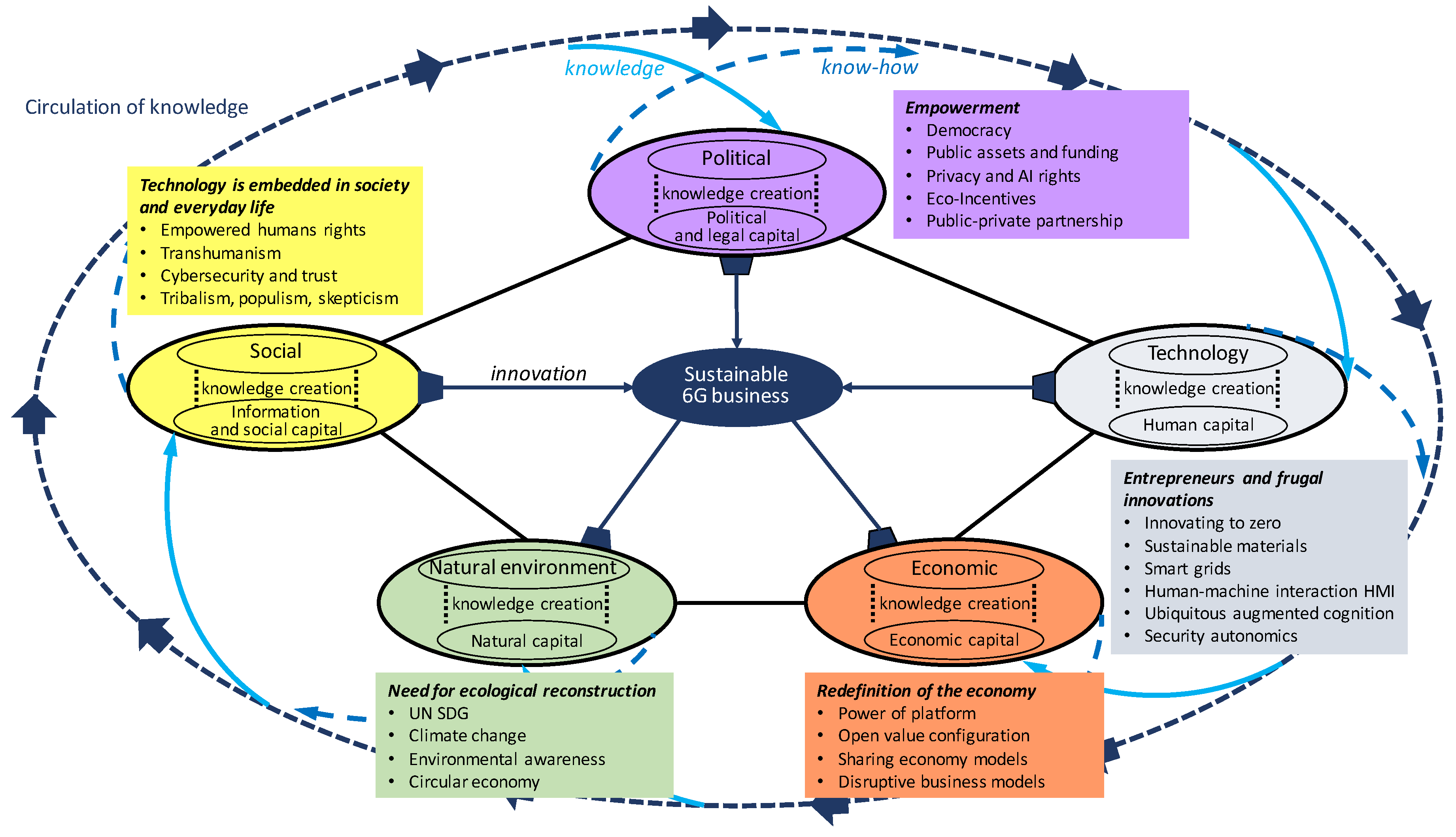
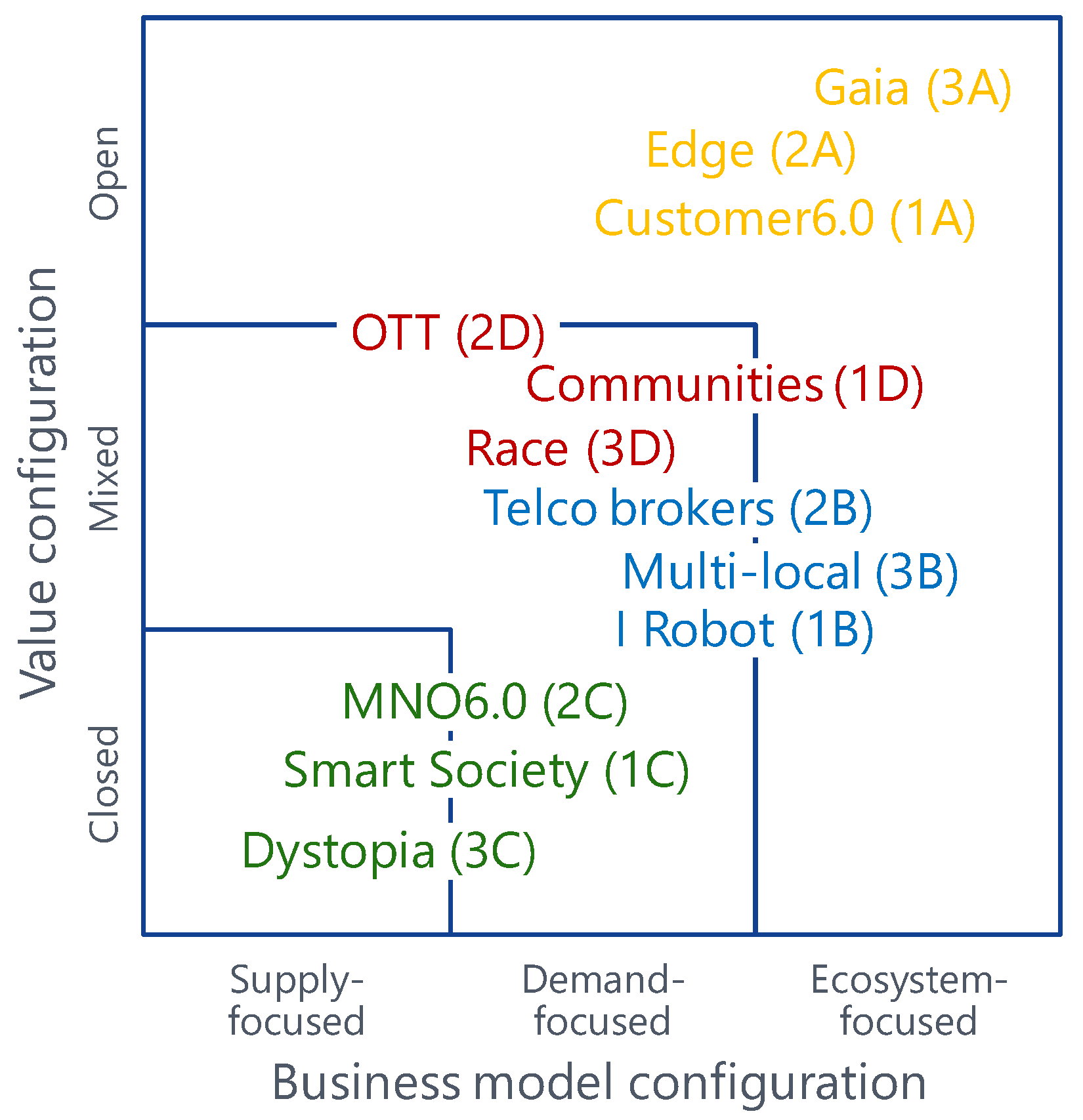

Publisher’s Note: MDPI stays neutral with regard to jurisdictional claims in published maps and institutional affiliations. |
© 2020 by the authors. Licensee MDPI, Basel, Switzerland. This article is an open access article distributed under the terms and conditions of the Creative Commons Attribution (CC BY) license (http://creativecommons.org/licenses/by/4.0/).
Share and Cite
Yrjölä, S.; Ahokangas, P.; Matinmikko-Blue, M. Sustainability as a Challenge and Driver for Novel Ecosystemic 6G Business Scenarios. Sustainability 2020, 12, 8951. https://doi.org/10.3390/su12218951
Yrjölä S, Ahokangas P, Matinmikko-Blue M. Sustainability as a Challenge and Driver for Novel Ecosystemic 6G Business Scenarios. Sustainability. 2020; 12(21):8951. https://doi.org/10.3390/su12218951
Chicago/Turabian StyleYrjölä, Seppo, Petri Ahokangas, and Marja Matinmikko-Blue. 2020. "Sustainability as a Challenge and Driver for Novel Ecosystemic 6G Business Scenarios" Sustainability 12, no. 21: 8951. https://doi.org/10.3390/su12218951
APA StyleYrjölä, S., Ahokangas, P., & Matinmikko-Blue, M. (2020). Sustainability as a Challenge and Driver for Novel Ecosystemic 6G Business Scenarios. Sustainability, 12(21), 8951. https://doi.org/10.3390/su12218951





